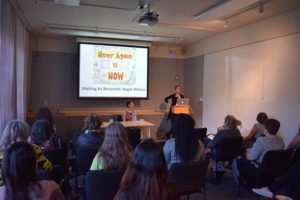Intertwined Threads
Laura Belik on Making as Research | Artist Talk with Angie Wilson, November 2, 2017
Artist Angie Wilson inspired the audience with her approach to textile art and the idea of “making” as a tool of empowerment. From “introspection rugs” to “protest curtains”, everyday objects are transformed through their materiality and meanings. Questions of tactility and texture intertwine with representation, individuality and resistance forming interactive pieces that are in conversation with numerous audiences, including our introspective selves.
 Highly influenced by utopian 20th Century Russia, Wilson explains how she incorporate their ideals of designing life as art. She reflects on how this had positive and negative outcomes. Repression in Russia at the time had many similarities with our political moment in the U.S. today, and art plays an important role of resistance. Nevertheless, we can also reflect on some interesting outcomes from that period. For example, “They eliminate gender”, she observes, “The spirit of the Russian revolution in costumes, for example, show efficiency and equalized bodies: everyone is a worker”. Wilson started her research on Russian constructivism while in college, and has carried some of their lessons through her own pieces ever since, especially when touching upon discussions of the body, gender and the transformative power of art practice.
Highly influenced by utopian 20th Century Russia, Wilson explains how she incorporate their ideals of designing life as art. She reflects on how this had positive and negative outcomes. Repression in Russia at the time had many similarities with our political moment in the U.S. today, and art plays an important role of resistance. Nevertheless, we can also reflect on some interesting outcomes from that period. For example, “They eliminate gender”, she observes, “The spirit of the Russian revolution in costumes, for example, show efficiency and equalized bodies: everyone is a worker”. Wilson started her research on Russian constructivism while in college, and has carried some of their lessons through her own pieces ever since, especially when touching upon discussions of the body, gender and the transformative power of art practice.
During her lecture, Wilson presented some of her work, starting with the “introspection rugs”. As she explained, they are “individual places for people to sit.” The viewer becomes a participant, and the drawings on the rugs are their internal landscapes. Inspired by interactive pieces such as Yoko Ono’s “Painting to be stepped on” (1960/61), Wilson believes in the interaction between the artwork and the viewer, and the “introspection rugs” have the potential to make those connections. Her work with rugs continued through a series she did called “Hand Knotted”. By re-using sleeves and pieces from worn clothing, the artist reflects on the material production of labor.
A turning point for her practice occurred while fighting cancer. “During the hours of chemotherapy, I started to embroider”, Wilson remembered. Using garments from the hospital as her canvas, she understood those pieces of clothing as very powerful objects, representing the transformations of people’s bodies before and after going through radiation and other procedures. “Getting one’s body radiated in order to become healthy was a bizarre experience”. Another outcome of her work dealing with the radiation treatment was in the way she perceived light and color, and her reflections over space images.
Using fluorescent colors, through yarn and light Wilson started creating images that would reflect on space and time. The forms create the illusion of different dimensions, as well as movement and vibrations. Named “Luminous Matter”, those hypnotic works can be viewed as portals to external and internal universes.
More recently, since Donald Trump’s election, Wilson felt the need to engage her work as part of a resistance movement. Besides her work with youth groups as a costume designer at Destiny Arts, in Oakland, she also started leading workshops to create “Protest Curtains”. Like her project with rugs, these everyday object gain an entire new meaning as a communication tool. Carrying messages of empowerment, the goal of this project is to resist racism, xenophobia and inequality. “the curtains are facing our streets, and encourage messages of love and resistance”. Wilson recalls her background and research on Russian Constructivism and reflects on how we can make the connections and parallels between totalitarian regimes and governmental power then and now, and what our role should be in fighting for our rights. “Through art we can create a community, build solidarity”.
Laura Belik (PhD Student, Architecture) reviewed the November 2, 2017 presentation and conversation, Making as Research | Artist Talk with Angie Wilson, the third program in a series of events this academic year focusing on arts practice as research.
